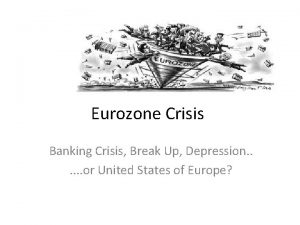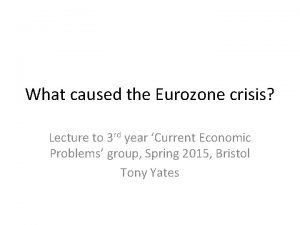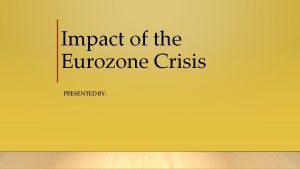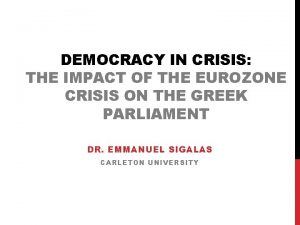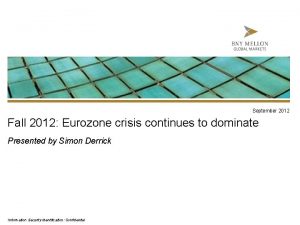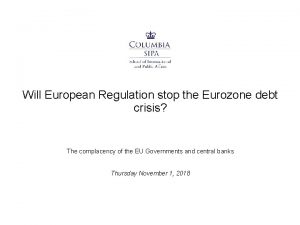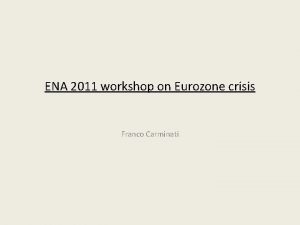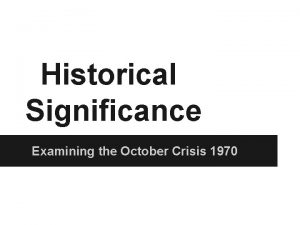The Eurozone Crisis in a Historical Perspective Its






























- Slides: 30


The Eurozone Crisis in a Historical Perspective: Its Preconditions and Consequences EUSP Practitioner Lectures in Finance 11 November 2011 Maxim Bouev European University at St. Petersburg mbouev@eu. spb. ru

Outline l So, what’s exactly going on in Europe? l The main stylised facts and problems: a) Europe, in particular b) the modern (Western) economy, in general Whence did Europe come: trade as an engine to development on the continent l Monetary arrangements facilitating trade: a brief history of the XX century l l The Eurozone dilemmas l Solutions and resolutions l Perspectives: whither Europe and the World?

So, what’s exactly going on in Europe? l 1999, Launch of the Euro: “Inspiration for the € symbol came from the Greek letter epsilon…crossed by two parallel lines to ‘certify’ the stability of the euro. ” European Commission So, € - ἒ ψιλόν, "simple e", united and stable Europe l Main ideas behind the EMU: - reduce trading costs - boost tourism - streamline the economy

So, what’s exactly going on in Europe? (continued) l What went wrong? Most European governments run budget deficits: debt burden has kept increasing over the past few years

So, what’s exactly going on in Europe? (continued) l What went wrong? Most European governments run budget deficits: debt burden has kept increasing over the past few years

So, what’s exactly going on in Europe? (continued) l What went wrong? Debt in itself is fine, however, as long as markets BELIEVE that countries and their governments can repay their debt. If they stop believing they start demanding higher interest on funds provided: new borrowing becomes difficult if at all possible! As of a month ago, yields on 10 year gov. bonds: Germany France Spain Italy Ireland Portugal Greece 2. 05 % 2. 83 % 4. 95 % 5. 56 % 7. 41 % 10. 80 % 22. 14 % Source: Bloomberg

So, what’s exactly going on in Europe? (continued) l What went wrong? If/when governments cannot borrow/service their debt they start asking for emergency loans (IMF, EC): Greece € 110 bn. in May 2010 Ireland € 85 bn. in November 2010 Portugal € 78 bn. in May 2011 However, even emergency loans come with strings attached: they need to be repaid!!. . BUT: Total Greek debt person Average Greek salary in 2008 € 340 bn. € 31, 000 € 25, 915 Source: BBC/Eurostat

So, what’s exactly going on in Europe? (continued) l What went wrong? What if Greece can’t repay its debts and defaults?

So, what’s exactly going on in Europe? (continued) l …well, a solution then is to kick the Greece out of the Eurozone, or is it? However, as markets are driven inter alia by BELIEFs, Greece’s departure might cause CONTAGION: Portugal, Spain, Ireland, Italy, France would follow. The END of the EURO. Bye!

Stylised facts and problems OK then, what have we learned from the situation so far? paramount: economic trade drives unification of Europe (hence the idea of no barriers, common currency, common policy, etc. ) l for some reason nowadays the economic system works the way that governments can borrow so much as to drive their economies to the brink of a collapse… l …but the collapse, if happens, is closely linked to the behaviour of markets, formation of BELIEFs and EXPECTATIONs, in other words, such things as CONFIDENCE matter (cf ‘animal spirits’ of David Hume, 1739; J. M. Keynes, 1936; George Akerlof and Robert Shiller, 2009; ‘multiple equilibria’ and ‘self-fulfilling profecies’ of Alberto Alesina et al. , 1989) l

Whence did Europe come? Let’s take an historical perspective… l trade in the XIX century: formation of the Gold Standard Britain --> France --> United States --> Russia l the price-specie flow model (David Hume, 1752; the Cunliffe Committee, Bo. E, 1919) l l l currencies linked to gold capital freely flows around the world FX rates are stable Britain is in the centre of the world trade: managing Bo. P is EASY! Balance of Payments, in broad sense: Current Account + Capital Account + balancing term = 0 l also important: peace (1870 - 1914) and international cooperation

Whence did Europe come? (continued) any deviation in trade in Hume’s model causes capital to flow, and put FX rate under stress l l then governments could NOT run deficits or had to - debase currency (hidden, cf Reinhart and Rogoff, 2009) - devalue currency (open) - default (sometimes) - deflate (usual option) in practice, flows of capital automatically cause the economy to stabilise before severe price deflation is needed l the system works the way that in the absence of parliamentary democracy markets BELIEVE that governments are committed to the stability of the exchange rates (Eichengreen, 2008) l

Monetary arrangements facilitating trade l Gold standard and the Latin Monetary Union (1865 - 1927) - no capital controls - currency peg facilitates trade - commitment to peg (fiscal and monetary policy) - no political pressure - CBs did not have to be the lender of last resort (LLR) …and, btw, Greece was ejected in 1908 forging/debasement of the currency l WWI and free float of currencies (at the beginning of the 1920 s) l Gold-exchange standard (1925 – 1936): it did not work because - parliamentary democracy matters (unemployment is bad!) - governmental commitment to the ccy peg is questionable - markets updated their BELIEFs - …while politicians did not! - Britain is NO longer the centre of trade - countries failed to cooperate on economic policies

Monetary arrangements facilitating trade (continued) Managed float of ccys (the 1930 s), collapse of the international trade and the WWII l Implementation of the Bretton-Woods Agreements (1944 - 1973) was another attempt to re-construct the international trade as it was known at the time of the Gold standard l - free trade (Current Account is open) - no international capital mobility (Capital Account is closed) - fixed FX rates l This system COULD work (for some time, that is) because - as CA is closed governmental commitment to ccy peg was plausible (cf the Impossible ‘Unholy’ Trinity in the Mundell. Fleming model, i. e. IS-LM-BP, 1960 s) - monetary policy respected the ‘pressure of democracy’ - markets BELIEVEd that FX rates are to stay fixed

Monetary arrangements facilitating trade (continued) l That (B-W) system could NOT work because - liberalisation of trade / convertibility of the Current Account lead to liberalisation of the Capital Account - governmental commitment to ccy peg became not plausible - CBs could no longer be the LLR - markets no longer BELIEVE in ccy peg

Monetary arrangements facilitating trade (continued) l Aftermath of the Bretton-Woods (since 1973) - fully floating FX rates: big countries, somewhat self-dependent, such as USA and Japan - full pegs, currency boards: small economies, such as Hong-Kong or Ecuador - in between was Europe: collective adjustable pegs ‘the snake in the tunnel’ (based on Smithsonian Agreement 1971: widening of B-W ccy bands from 1% to 2. 25%) ‘the snake in the lake’ (abolition of ccy bands 1973 - 1978)

So what’s the matter with Europe? l “Because it’s there!” *, that is, geography matters European countries wanted to avoid currency fluctuations, restore currency pegs to facilitate trade in the region l However, the oil shocks in the 1970 s made a transition to common European currency not possible during that time l *) a misquote from George Leigh Mallory, an Everest explorer of the 1920 s

What does that all mean? Interim summary 1. We have - many countries that want to trade, remove barriers, stabilise capital flows - capital flows freely, can be destabilising - democracy, political parties (unemployment is bad!) - trade is truly international (many centres) - a country is stable in the long run if its Bo. P (broadly understood) is zero 2. Because of the Impossible Trinity and formation of market BELIEFs: - EITHER currencies can be freely floating and then international cooperation is not necessarily needed, Bo. P will be self-correcting and governments won’t be able to run sustained deficits, CB can be the LRR - OR currencies can be pegged, but then for the governments to run sustained deficits correction of Bo. P is possible only through international cooperation (integration, redistribution of surpluses), CB can’t be the LRR

The Eurozone European Monetary System (1979 - 1991) was an attempt to comprehend the failure of the Snake, find ways of stabilising flows of capital, and move towards a full currency peg (the ecu was introduced) l EMS, however, collapsed because of the widening of the currency band, inability to negotiate the necessary redistribution of surpluses, and a failure to cooperate on the part of European central banks l l Finally, the steps towards full liberalisation of trade in Europe - common market (the Treaty of Rome, 1958) - the vision of common monetary policy (Jacques Delors’ report to the European Commision, 1989) - the Maastricht Treaty (1991): 4 conditions on potential members of the common-currency area l Introduction of the Euro (1999)

The problems with the Eurozone But we do have the following problems here (of course!): - the Eurozone introduced a fixed currency peg (monetary union), a common monetary policy (European Central Bank), but forbade fiscal transfers among the countries, while equipping them only with some rules for fiscal prudency, which had been not properly honoured - however, markets believe in the Unholy Trinity - so, under the broad conditions of the Eurozone (democracy, governments running budget deficits, ect) it all works fine until the market (read – free flow of capital) decides to switch to German bonds (Gary Lineker, a footballer: “Germany are Germany!”) - under conditions of an economic crisis such a switch can be fatal UNLESS there is a re-distribution of surpluses (cf USA, the failure of EMS)

The Eurozone dilemmas l Borrowers vs Lenders: Greece vs Germany l Austerity vs Growth: well, it’s a crisis, inn’it? Discipline vs Solidarity: “learn the lesson or get out” vs “let’s help ‘em” (cf redistribution of wealth between states in the USA) l l Common Europe vs the Nations: looking fwd vs looking backward (“Because it’s there!” – remember? )

Solutions and resolutions Ok, now, the ECB is buying up Greeks and Italian bonds in the secondary market (as direct transfer of money, i. e. buying in the primary market, is not possible: ECB is independent, remember? ) l EFSF and all that: insurance, Special Purpose Investment Vehicle (SPIV), etc l The idea: calm down the markets, shift them back to good equilibrium (cf Alberto Alesina et al. , 1989) l But the fact of the matter: more integration is needed on the fiscal front – common bonds, fiscal transfers (cf George Soros and Co) l

Whither the mess? Ok, then, for now there are three likely scenarios (the following I reproduce from the BBC website)…

Scenario I “Countries muddle through” Leaders introduce measures on a gradual basis to try to contain the problem l Likely impact: uncertainty and risk remain and the restoration of market confidence is delayed l The lack of confidence has a negative effect on borrowing costs and growth, not just in Greece and other Eurozone countries, but elsewhere l Recession becomes a near certainty in Japan, Greece, Portugal, Italy and Spain. The probability of a recession in the UK rises to about 70% l

Scenario II “Economy after economy defaults” A default in one country, such as Greece, forces other vulnerable Eurozone economies to default l Likely impact: once Greece defaults, other countries become more likely to default as investors become worried about risks in the region l Other European banks and pension funds that hold large amounts of Greek debt would also face losses l Portugal is the most likely next candidate for default. Other vulnerable countries include Ireland, Spain and Italy l Defaults by several Eurozone countries would make a generalised banking crisis likely l The end of the Euro…. for the time being that is! l

Scenario III “Greece exits the Euro” Allowing or forcing Greece to leave the Eurozone l Likely impact: Greek devaluation would be certain - as investors would attach a high risk to the country - and default would be likely l A run on Greek banks would follow, meaning a collapse of the Greek financial system l International creditors would incur huge losses, Greek businesses would go bust, and the Greek people would face high inflation l Other possible consequences are mass emigration, especially of skilled labour, towards other EU countries offering higher wages. l There could also be new barriers to trade l

References I Ahamed L. (2009) Lords of Finance: The Bankers Who Broke the World Akerlof G. , Shiller R. (2009) Animal Spirits: How Human Psychology Drives the Economy, and Why It Matters for Global Capitalism l Alesina A. , Prati A. , Tabellini G. (1989) Public Confidence and Debt Management: A Model and A Case Study of Italy, CEPR Discussion Papers 351 l Eichengreen B. (2008) Globalizing Capital. A History of the International Monetary System l Hume D. (1739) A Treatise of Human Nature l Hume D. (1752) On the Balance of Trade l Keynes J. M. (1936) The General Theory of Employment, Interest and Money l Reinhart C. , Rogoff K. (2009) This Time is Different: Eight Centuries of Financial Folly l l

References II RBS research l Bloomberg l Eurostat l BBC l Wikipedia l Slon. ru l

 Eurozone population
Eurozone population Gravis grave
Gravis grave History of the community
History of the community Materials in historical perspective
Materials in historical perspective Major historical perspective of nursing and computer
Major historical perspective of nursing and computer History of midwifery in india ppt
History of midwifery in india ppt Alexander gerschenkron economic backwardness
Alexander gerschenkron economic backwardness Stairs one point perspective
Stairs one point perspective Silo perspective vs business process perspective
Silo perspective vs business process perspective If its square its a sonnet
If its square its a sonnet Emigree poem analysis
Emigree poem analysis Its halloween its halloween the moon is full and bright
Its halloween its halloween the moon is full and bright When a train increases its velocity its momentum
When a train increases its velocity its momentum Its not easy but its worth it
Its not easy but its worth it Cloudy windy rainy sunny
Cloudy windy rainy sunny ưu thế lai là gì
ưu thế lai là gì Thẻ vin
Thẻ vin Bàn tay mà dây bẩn
Bàn tay mà dây bẩn Các châu lục và đại dương trên thế giới
Các châu lục và đại dương trên thế giới Bổ thể
Bổ thể Từ ngữ thể hiện lòng nhân hậu
Từ ngữ thể hiện lòng nhân hậu Tư thế ngồi viết
Tư thế ngồi viết Giọng cùng tên là
Giọng cùng tên là 101012 bằng
101012 bằng Thể thơ truyền thống
Thể thơ truyền thống Alleluia hat len nguoi oi
Alleluia hat len nguoi oi Sự nuôi và dạy con của hổ
Sự nuôi và dạy con của hổ đại từ thay thế
đại từ thay thế Diễn thế sinh thái là
Diễn thế sinh thái là Vẽ hình chiếu vuông góc của vật thể sau
Vẽ hình chiếu vuông góc của vật thể sau Công thức tiính động năng
Công thức tiính động năng
































